These NCERT Solutions for Class 8 Science Chapter 9 Reproduction in Animals Questions and Answers are prepared by our highly skilled subject experts to help students while preparing for their exams.
Reproduction in Animals NCERT Solutions for Class 8 Science Chapter 9
Class 8 Science Chapter 9 Reproduction in Animals Textbook Exercise Questions and Answers
Page 110-111
Question 1.
Explain the importance of reproduction in organisms.
Answer:
Reproduction is very important for the organisms. The organisms reproduce to generate young ones like them. It helps to maintain their existence generation after generation. If reproduction does not take place, no living being will survive on the earth. Had the process of reproduction not been there, all the plants and animals would have become extinct. Secondly, special characters of an organism are carried over to its next generation through reproduction only.
Question 2.
Describe the process of fertilisation in human beings.
Answer:
The mode of reproduction in human beings is sexual reproduction. Ovaries in females produce ova while the testes in males produce sperms. Millions of sperms are ejected inside the female reproductive tract where one of them fuses with the ovum and forms zygote. This process is known as internal fertilisation. The zygote, then, begins to develop into an embryo which attaches to the female uterus wall.
Question 3.
Choose the most appropriate answer:
a. Internal fertilisation occurs
(i) in female body
(ii) outside female body
(iii) in male body
(iv) outside male body
Answer:
(i) in female body
b. A tadpole develops into an adult frog by the process of
(i) fertilisation
(ii) metamorphosis
(iii) embedding
(iv) budding
Answer:
(ii) metamorphosis
c. The number of nuclei present in a zygote is
(i) none
(ii) one
(iii) two
(iv) four
Answer:
(ii) one
Question 4.
Indicate whether the following statements are True (T) or False (F):
a. Oviparous animals give birth to young ones. ( )
b. Each sperm is a single cell. ( )
c. External fertilisation takes place in frog. ( )
d. A new human individual develops from a cell called gamete. ( )
e. Egg laid after fertilisation is made up of a single cell. ( )
f. Amoeba reproduces by budding. ( )
g. Fertilisation is necessary even in asexual reproduction. ( )
h. Binary fission is a method of asexual reproduction. ( )
i. A zygote is formed as a result of fertilisation. ( )
j. An embryo is made up of a single cell. ( )
Answer:
a. False
b. True
c. True
d. False
e. False
f. False
g. False
h. True
i. True
j. False
![]()
Question 5.
Give two differences between a zygote and a foetus.
Answer:
| Zygote | Foetus |
| a. It is formed after the fusion of the sperm with the egg cell. | a. It is a mature stage of the embryo that shows all the main recognisable body parts resembling a mature organism. |
| b. The zygote divides several times to ^ form an embryo. | b. An embryo gradually develops into a foetus. |
Question 6.
Define asexual reproduction. Describe two methods of asexual reproduction in animals.
Answer:
When a single parent is involved in reproduction and gametes are not formed, it is called asexual reproduction. Two methods of asexual reproduction are as follows:
i. Budding: Budding involves the formation of a new individual from the bulges or outgrowths, known as buds, formed on the parent body. This method of reproduction is common in Hydra. In Hydra, the cells divide rapidly at a specific site and develops into an outgrowth, called the bud. These buds, while being attached to the parent plant, develop into smaller individuals. When these individuals become mature enough, they detach from the parent’s body and become independent individuals.
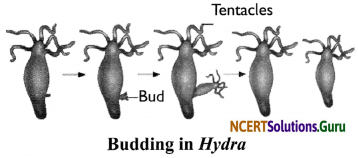
ii. Binary Fission: It is a type of asexual reproduction in which a single cell divides into two halves. Organisms that reproduce through binary fission are bacteria and Amoeba. In Ainoeba, the division of cells can take place in any plane. It involves the division of its nucleus into two nuclei, which is followed by the division of the cytoplasm into two halves. Each half of the body receives a nucleus.
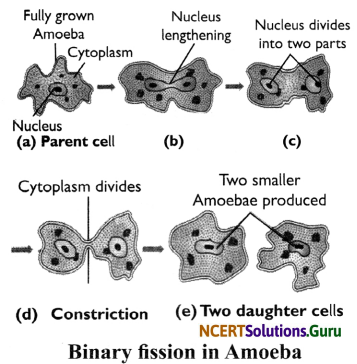
Question 7.
In which female reproductive organ does the embryo get embedded?
Answer:
The embryo gets embedded in the wall of the uterus. The embryo, while it is still attached to the uterus, gradually develops the various body parts such as hands, legs, head, eyes, etc. The embryo at this stage is called a foetus.
Question 8.
What is metamorphosis? Give examples.
Answer:
In case of indirect development, the transformation of the young ones into an adult through drastic changes is called metamorphosis. Larva of butterfly undergoes metamorphosis to become a butterfly. A tadpole undergoes metamorphosis to become a frog.

The tadpole that emerges from the egg contains gills, a tail and a small circular mouth. It can swim freely in water. The tadpole grows and undergoes abrupt changes in its structure and develops into a mature frog. A tadpole’s metamorphosis begins with the development of limbs, lung development and finally the absorption of the tail by the body.
![]()
Question 9.
Differentiate between internal fertilisation and external fertilisation.
Answer:
|
Internal fertilisation |
External fertilisation |
| a. It involves the fusion of the male and the female gamete inside the female body. | a. It involves the fusion of the male and the female gamete outside the female body. |
| b. Chances of the survival of offspring are more. Therefore, a small number of eggs are produced. | b. Chances of the survival of the eggs are less. Therefore, a large number of eggs are produced. |
| c. Humans, cows, hens, etc., are various organisms showing internal fertilisation. | c. Fish, frog, starfish, etc., are the organisms showing external fertilisation. |
Question 10.
Complete the crossword puzzle using the hints given below.
Across
1. The process of the fusion of the gametes.
6. The type of fertilisation in hen.
7. The term used for bulges observed on the sides of the body of Hydra.
8. Eggs are produced here.
Down
2. Sperms are produced in these male reproductive organs.
3. Another term for in-vitro fertilisation.
4. These animals lay eggs.
5. A type of fission in
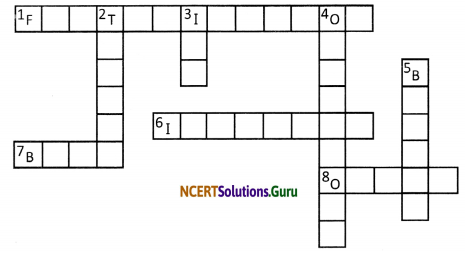
Answer:
1. Fertilisation
2. Testes
3. IVF
4. Oviparous
5. Binary
6. Internal
7. Buds
8. Ovary
NCERT Extended Learning Activities and Projects
Question 1.
Visit a poultry farm. Talk to the manager of the farm and try to find out the answers to the following.
a. What are layers and broilers in a poultry farm?
b. Do hens lay unfertilised eggs?
c. How can you obtain fertilised and unfertilised eggs?
d. Are the eggs that we get in the stores fertilised or unfertilised?
e. Can you consume fertilised eggs?
f. Is there any difference in the nutritional value of fertilised and unfertilised eggs?
Hint:
a. Layers are chickens raised for eggs and broilers are chickens raised for meat.
b. Yes, hens lay both the fertilised egg (if mating has occurred) and the unfertilised egg (according to light patterns if no mating has occurred).
c. Fertilised eggs are obtained by allowing hens to mate with roosters. Unfertilised eggs are obtained by exposing hens to suitable light patterns.
d. They are mostly unfertilised eggs.
e. Yes, fertilised eggs can be consumed.
f. No, there is no difference in the nutritional value of fertilised and unfertilised egg.
Question 2.
Observe live Hydra yourself and learn how they reproduce by doing the following activity:
During the summer months, collect water weeds from ponds or ditches along with the pond water and put them in a glass jar. After a day or so you may see several hydra clinging to the sides of the jar.
Hydra is transparent, jelly-like and with tentacles. It clings to the jar with the base of its body. If the jar is shaken, the hydra will contract instantly into a small blob, at the same time drawing its tentacles in. Now take out few hydras from the jar and put them on a watch glass. Using a hand lens or a binocular or dissection microscope, observe the changes that are taking place in their body. Note down your observations.
Hint:
Do it yourself.
![]()
Question 3.
The eggs we get from the market are generally the unfertilised ones. In case you wish to observe a developing chick embryo, get a fertilised egg from the poultry or hatchery which has been incubated for 36 hours or more. You may then be able to see a white disc-like structure on the yolk. This is the developing embryo. Sometimes if the heart and blood vessels have developed you may even see a red spot.
Hint:
Do it yourself.
Question 4.
Talk to a doctor. Find out how twinning occurs. Look for any twins in your neighbourhood, or among your friends. Find out if the twins are identical or non-identical. Also find out why identical twins are always of the same sex? If you know of any story about twins, write it in your own words.
Hint:
Twins are identical when they are formed due to a random splitting in the developing embryo which then develops into two different individuals. Since they are formed from the same zygote, their sex is always the same. However, non-identical twins are formed by the fertilisation of two different egg cells.
Activity 1
Objective: To observe and study the eggs of frog.
Procedure: Visit some ponds or slow-flowing streams during spring or rainy season and observe the colour and size of frog’s eggs floating on the water.
Observation: Amphibian eggs do not have a hard protective shell like the eggs of birds or reptiles. Frogs and toads lay eggs in jelly-like masses, and unless the eggs are covered with water, they will dry up and die.
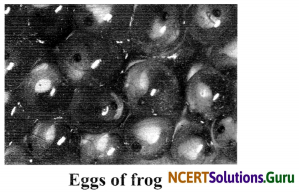
Most amphibian eggs become much bigger after they are laid because the eggs absorb water and swell up to several times their original volume. The colour of the eggs is dull white and size ranges from less than a centimetre to a few centimetres.
Asexual Reproduction: The type of reproduction in which only a single parent is involved is called asexual reproduction. It can be of the following major types:
i. Budding: This method is seen in multicellular organisms which are highly simple in structure. A small bud develops on the body. The bud grows and starts resembling its parent cell. After sufficient growth, the bud gets detached from the parent’s body to begin life as a new individual. Examples: Hydra and sponges reproduce by budding.
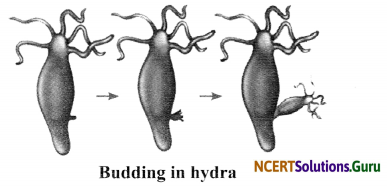
Activity 2
Objective: To study budding in Hydra with the help of permanent slide.
Materials Required: Permanent slide of Hydra and a compound microscope.
Procedure:
- Get permanent slides of Hydra, observe them using a hand lens or a microscope.
- First observe the slide under low power and then under high power.
- Note the features and draw rough sketches.
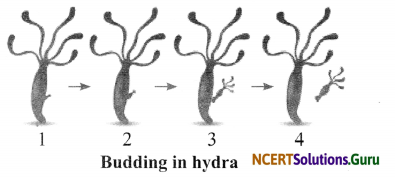
Observations:
- Hydra uses regenerative cells for reproduction in the process of budding.
- In Hydra, a bud develops as an outgrowth due to repeated cell division at one specific site.
- These buds develop into tiny individuals and when fully mature, they detach from the parent body and become new independent individuals.
Conclusion: Budding is an asexual mode of reproduction as it involves only a single parent.
ii. Binary Fission: This method is seen in unicellular organisms, e.g., Amoeba. Binary fission begins with nuclear division where the parent nucleus divides into two nuclei. This is followed by cytoplasmic division, with each part getting one nucleus. In this way, the cell of Amoeba divides into two daughter cells. Each daughter cell becomes a new individual.

Cloning: The offspring which is morphologically as well as genetically identical to its parent is called a clone. The process of producing clones is called cloning. In the process of cloning of Dolly, a cell was collected from the mammary gland of female Finn Dorsett sheep. Simultaneously an egg was obtained from a Scottish blackface ewe. The nucleus was removed from the egg cell and mammary gland cell’s nucleus was inserted in it. Development of egg followed normally and finally Dolly was born on 5lh July, 1996 in Scotland and was the first mammal to be cloned. It was found to be absolutely identical to the Finn Dorsett sheep, from which the nucleus was taken.
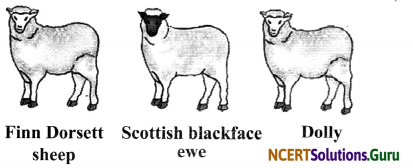
Class 8 Science Chapter 9 Reproduction in Animals Additional Important Questions and Answers
Very Short Answer Type Questions
Question 1.
What is sexual reproduction?
Answer:
When two parents are involved in the process of reproduction and gamete formation takes place, it is called sexual reproduction.
Question 2.
What is asexual reproduction?
Answer:
When a single parent is involved in reproduction and gamete formation does not take place, it is called asexual reproduction.
![]()
Question 3.
What is conception?
Answer:
Implantation of embryo in the wall of the uterus is called conception.
Question 4.
Give some examples of oviparous animals.
Answer:
Hen, lizards, all birds, etc.
Question 5.
Give some examples of viviparous animals.
Answer:
Cow, dog, cat and human beings.
Question 6.
Give the stages of development of a silk worm.
Answer:
Egg → Larva → Pupa → Adult
Question 7.
Name the male and female gametes.
Answer:
Mate gamete: Sperm Female gamete: Ovum
Question 8.
Name the reproductive organs of male and female.
Answer:
Male reproductive organs: Testes sperm ducts, penis.
Female reproductive organs: Ovaries, oviduct, uterus.
Question 9.
Name the male sex hormone.
Answer:
Testosterone.
![]()
Question 10.
Give the other name of oviduct.
Answer:
Fallopian tube.
Question 11.
What do you understand by the term ‘gestation’?
Answer:
It is the period between fertilisation and child birth, in which a foetus develops.
Question 12.
Name the female sex hormone.
Answer:
Estrogen.
Question 13.
Write the full form of IVF.
Answer:
In-vitro fertilisation.
Question 14.
Where does the development of embryo take place in the body of a female?
Answer:
The development of embryo takes place in the uterus of the female body.
Question 15.
What is foetus?
Answer:
A well developed embryo with distinct and identifiable body parts is called foetus.
![]()
Question 16.
Name the various methods of asexual reproduction in animals.
Answer:
Budding, fission, regeneration and fragmentation.
Question 17.
What type of reproduction takes place in Amoeba?
Answer:
Asexual reproduction (binary fission).
Short Answer Type Questions
Question 1.
What is the difference between sexual and asexual reproduction?
Answer:
|
Asexual reproduction |
Sexual reproduction |
| a. Only one parent is involved. | a. Two parents, one male and one female, are involved. |
| b. Gametes are not involved. | b. Gametes are involved. |
| c. Offsprings formed are genetically identical to the parent. | c. Offsprings formed are genetically different from the parent. |
| d. Multiplication occurs faster. | d. Multiplication is slower. |
| e. Examples are Amoeba, Hydra. | e. Examples are fishes, mammals and reptiles. |
Question 2.
Briefly explain in-vitro fertilisation.
Answer:
Any biological process carried out in laboratory is called ‘in-vitro’ process. Thus, fertilisation carried out in laboratory is called in-vitro fertilisation. Many women may fail to conceive due to certain problems. In-vitro fertilisation helps such women to bear a child. In this technique, a freshly released sperm (from the father) and an ovum (from the mother) are collected and allowed to fuse under artificial conditions. After in-vitro fertilisation, zygote is allowed to develop into a mass of cells and is then transferred into the uterus for subsequent development.
Question 3.
Explain the steps of development of embryo.
Answer:
Conception and child birth: It takes place in the female reproductive system through the following steps:
- A single egg comes out of the ovary every month and reaches the fallopian tube.
- Sperms reach the fallopian tube where a sperm fertilises the egg. This results in the formation of zygote.
- Zygote undergoes several rounds of cell division to become a ball of cells.
- The cells begin to form groups that develop into different tissues and organs of the body. This structure is called embryo.
- This embryo moves down and gets implanted in the wall of the uterus. This process is called conception. Conception marks the beginning of pregnancy.
- Embryo develops further inside the uterus to form various body parts such as hands, head, eyes, etc. This stage of embryo is called foetus.
- When the development of the embryo is complete, the mother gives birth to the baby.
![]()
Question 4.
Describe the male reproductive organs.
Answer:
The male reproductive organs are a pair of testes, sperm ducts and a penis. Testes produce male gametes called sperms. The two sperm ducts open into the top of urethra. Urethra carries both the sperms and the urine. The urethra is a narrow tube and runs through the penis to the outside.
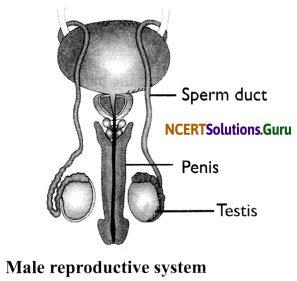
Question 5.
Differentiate between budding and binary fission.
Answer:
| Budding | Binary fission |
| 1. The parent individual persists after the daughter individual has budded off. | 1. The parent individual loses its identity after splitting into two daughter individuals. |
| 2. Bud starts as a trace and slowly grows to an appropriate size. | 2. The daughter individuals are identical in structure but all are smaller in size than the parent. Later they grow to attain their normal dimensions. |
| 3. Budding is rather slow and gradual. | 3. Fission is rapid and instantaneous. |
Question 6.
Describe the female reproductive organs.
Answer:
Female reproductive organs include a pair of ovaries, oviduct and the uterus. In human beings, a single matured egg is released into the oviduct by one of the ovaries every month. Fallopian tube carries the egg from ovaries to the uterus. Uterus is the part where development of the baby takes place.
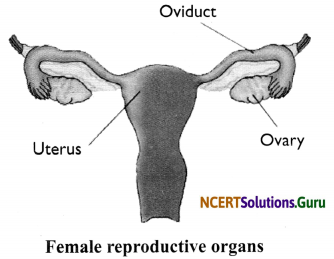
Question 7.
Define sperm. Describe its structure.
Answer:
The testes secrete millions of sperm cells together. A sperm comprises a single cell and has a specific structure with three main parts as given below:
a. Head: It consists of the nucleus which contains the DNA information of the cell.
b. Middle Piece: It is packed with cell organelle called mitochondria. The mitochondria are responsible for producing energy in the cell. Sperm uses this energy to move.
c. Tail: It allows the sperm cell to travel at a fast pace.
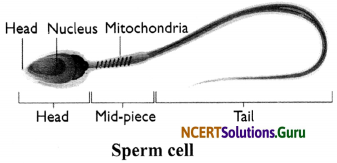
Question 8.
Define ovum. Describe its structure.
Answer:
Ovum or egg is the female gamete which produces zygote after fertilisation with the male gamete. An ovum is single-celled and spherical in shape. If consists of a prominent nucleus and a dense cytoplasm which is full of nutrition.
![]()
Question 9.
What are test-tube babies?
Answer:
In some women, the oviducts are blocked and hence the eggs are unable to reach the uterus. This means that these women are not able to bear babies because of blocked oviducts. However, due to the process of in-vitro fertilisation or IVF, the freshly released eggs of females and the male sperms can be fertilised externally. The zygote thus formed is allowed to develop for a week outside the female body in safe conditions and is then placed in the mother’s uterus. In this way, these women can bear babies. The babies that are born with the IVF process are called test-tube babies.
Question 10.
Why are gametes produced in large numbers in organisms that exhibit external fertilisation?
Answer:
Organisms that take part in external fertilisation produce a large number of gametes because:
a. in external fertilisation, there is a great chance that the sperms and the eggs released by the organisms can be affected by the environmental factors, like desiccation, predators, etc. So, to compensate for the high mortality rate of the gametes, the organism produces a large number of gametes.
b. producing a large number of gametes increases the chances for at least some eggs and sperms to fuse in the environment ensuring that at least a stable number of offspring are produced.
Question 11.
How are chicks born? Explain their developmental process.
Answer:
After fertilisation the zygote divides repeatedly and travels down the oviduct. As it travels down, many protective layers are formed around it. The hard shell on the hen’s egg is one such protective layer. The hen finally lays the egg. The embryo takes about three weeks to develop into a chick. After the chick is completely developed, it bursts open the egg shell and hatches out.
Question 12.
How are general growth and sexual maturation different from each other?
Answer:
General growth refers to different types of developmental process in the body like increase in height, weight gain, changes in shape and size of the body but sexual maturation is specific to change reflected at puberty like cracking of voice, new hair patterns, development of breast in female, etc.
Question 13.
Explain the life cycle of silkworm in brief.
Answer:
The adult lays eggs on mulberry leaves. The caterpillar hatches out from the egg and feeds actively. If then converts itself into pupa. The pupa stage is inactive. This pupa finally metamorphosis into the adult silk moth. Hence, following stages can be summed up in the life cycle of a silkmoth:
Egg → Larva or Caterpillar → Pupa → Adult
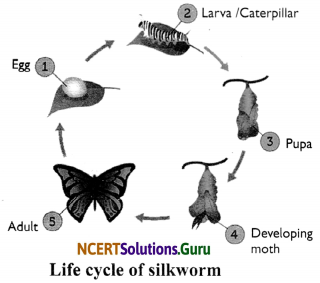
Question 14.
Explain the process of fertilisation in frogs.
Answer:
Frogs undergo external fertilisation. During rainy season, they move to ponds and slow flowing streams. The female lays hundreds of eggs which are not covered by a shell and are very delicate. A layer of jelly holds the eggs together and provides protection. The male deposits sperms over these eggs. The sperms swim randomly in water and fuse with the eggs resulting in fertilisation.
![]()
Question 15.
Birth of a new born baby in a family is rejoicing and celebrating. Unfortunately, about 3% of the new born suffer from one of the other birth defects.
a. What are the factors that cause such defects?
b. List the different techniques being used towards parental diagnosis of such anomalies.
c. How are these techniques useful in counselling for such cases?
Answer:
a. Anomalies are due to a number of genetic and environmental factors.
b. A number of techniques are available nowadays for detecting such disorders. These include blood test of the mother and ultrasound, etc.
c. Based on these reports, expert advice is sought for continuation of pregnancy through suitable medical treatment or for termination of pregnancy.
Long Answer Type Questions
Question 1.
What is reproduction? Describe the various modes of reproduction.
Answer:
Reproduction is the process by which living organisms produce more living organisms of their own kind. It helps in the continuation of a species on the earth.
Modes of Reproduction: There are two main modes of reproduction in living organisms:
a. Asexual reproduction: The mode of reproduction in which a single organism is able to produce one or more organisms of its kind by itself is called asexual reproduction. Asexual reproduction does not require the involvement of both the male and the female. The organisms like Amoeba, yeast, Hydra, etc., reproduce by this mode of reproduction.
b. Sexual reproduction: In sexual mode of reproduction, both the parents (male and female) are needed to produce individuals of the same kind. Fish, frog, higher animals such as cow, dog, horse and human beings reproduce by the mode of sexual reproduction.
Question 2.
Describe the formation of egg shell in hens.
Answer:
Internal fertilisation takes place in hens. After fertilisation, the zygote divides continuously and moves to the oviduct. As it travels down, many protective layers are formed around it. The hard shell in a hen’s egg is one such protective layer. After the hard shell is formed, the hen finally lays the egg. The embryo takes about 3 weeks to develop into a chick.
The hen sits on the eggs to provide sufficient warmth. After the chick is completely developed, it bursts open the egg shell.
![]()
Question 3.
Define cloning. Describe the formation of Dolly.
Answer:
Cloning is the process of production of an exact copy of a cell, any other living part, or a complete organism. Cloning process of an animal was successfully performed for the first time by Ian Wilmut and his colleagues at the Roslin Institute in Edinburgh, Scotland. They successfully cloned a sheep named Dolly.
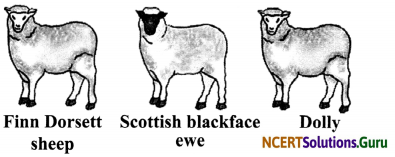
During the process of cloning a sheep named Dolly, a cell was collected from the mammary gland of a female Finn Dorsett sheep. Simultaneously, an egg was collected from a Scottish blackface ewe. The nucleus was removed from the egg. After that, the nucleus of the mammary gland cell from the Finn Dorsett sheep was inserted into the egg of the Scottish blackface ewe whose nucleus had been removed. Then this egg was implanted into the Scottish blackface ewe. Development of this egg followed normally and then finally Dolly was born. It was found to be absolutely identical to the Finn Dorsett sheep, from which the nucleus was taken.
Picture-Based Questions
Question 1.
Draw a labelled diagram to show the male reproductive system in human beings.
Answer:
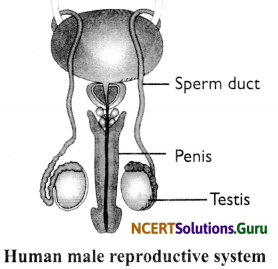
Question 2.
Draw a labelled diagram to show the female reproductive system in human beings.
Answer:
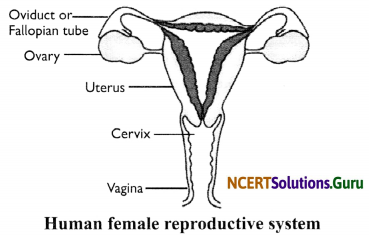
Question 3.
Observe the given figure and answer the questions that follow.
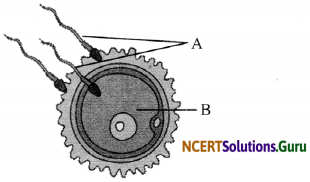
a. Name the components labelled A and B.
b. Identify the process.
c. What happens during the process and what is formed?
Answer:
a. A-sperms, B-ovum (egg).
b. The process is fertilisation.
c. During the process, the sperm nucleus fuses with the egg nucleus; as a result of which, a zygote is formed.
![]()
Question 4.
Identify the following diagram and answer the questions:
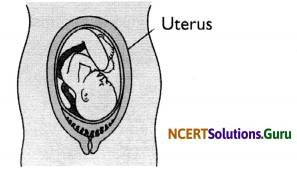
a. Where does the embryo develop in human body?
b. How many days does an embryo take to develop into a fully mature foetus.
Answer:
The diagram shows the development of foetus inside the uterus.
a. The embryo develops inside the uterus of the human female body.
b. The embryo takes about 270 to 280 days to develop into a fully mature foetus.
Question 5.
a. Draw the diagram of a human sperm and label its head, middle piece and tail.
b. What is the function of its tail?
Answer:
a.
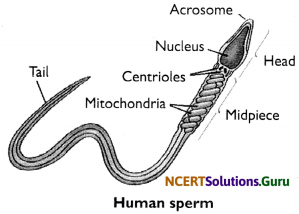
b. The tail of the sperm helps it in swimming in the liquid medium.